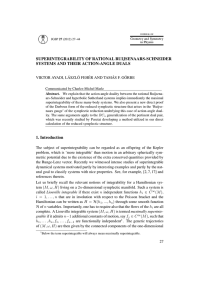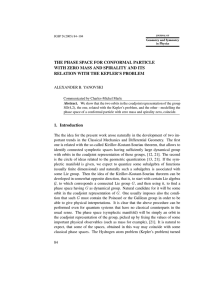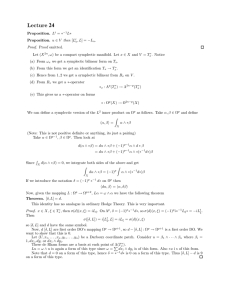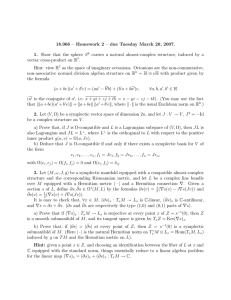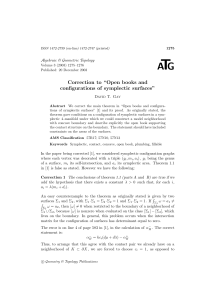SYMPLECTIC GEOMETRY, LECTURE 21
advertisement
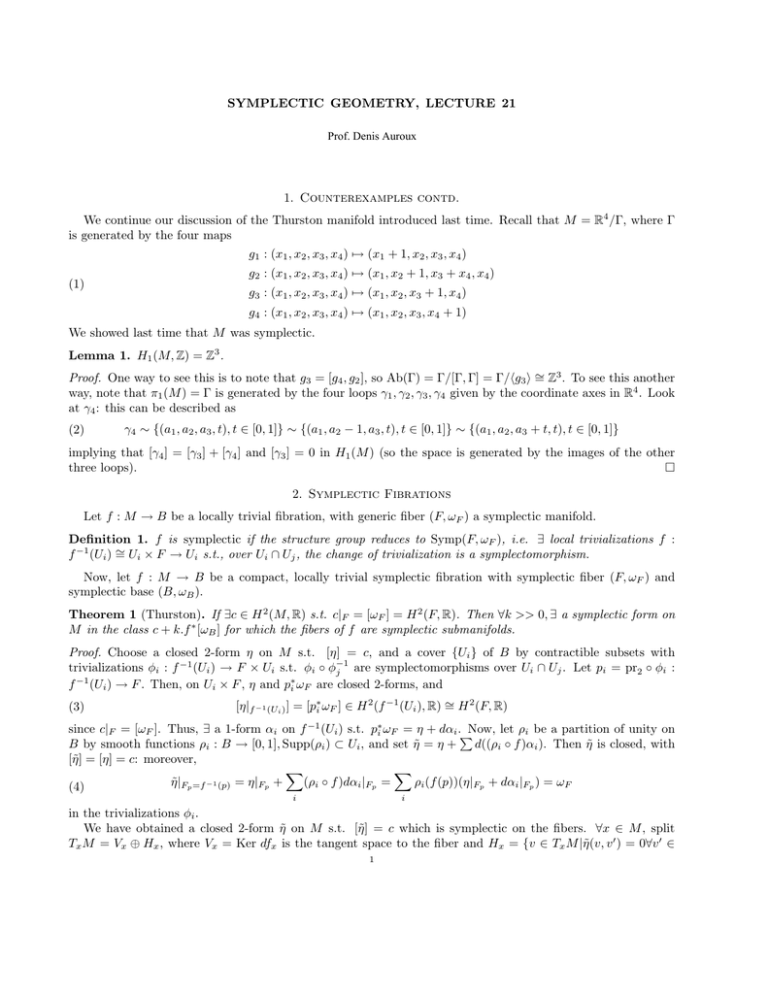
SYMPLECTIC GEOMETRY, LECTURE 21
Prof. Denis Auroux
1. Counterexamples contd.
We continue our discussion of the Thurston manifold introduced last time. Recall that M = R4 /Γ, where Γ
is generated by the four maps
g1 : (x1 , x2 , x3 , x4 ) �→ (x1 + 1, x2 , x3 , x4 )
g2 : (x1 , x2 , x3 , x4 ) �→ (x1 , x2 + 1, x3 + x4 , x4 )
(1)
g3 : (x1 , x2 , x3 , x4 ) �→ (x1 , x2 , x3 + 1, x4 )
g4 : (x1 , x2 , x3 , x4 ) �→ (x1 , x2 , x3 , x4 + 1)
We showed last time that M was symplectic.
Lemma 1. H1 (M, Z) = Z3 .
Proof. One way to see this is to note that g3 = [g4 , g2 ], so Ab(Γ) = Γ/[Γ, Γ] = Γ/�g3 � ∼
= Z3 . To see this another
way, note that π1 (M ) = Γ is generated by the four loops γ1 , γ2 , γ3 , γ4 given by the coordinate axes in R4 . Look
at γ4 : this can be described as
(2)
γ4 ∼ {(a1 , a2 , a3 , t), t ∈ [0, 1]} ∼ {(a1 , a2 − 1, a3 , t), t ∈ [0, 1]} ∼ {(a1 , a2 , a3 + t, t), t ∈ [0, 1]}
implying that [γ4 ] = [γ3 ] + [γ4 ] and [γ3 ] = 0 in H1 (M ) (so the space is generated by the images of the other
three loops).
�
2. Symplectic Fibrations
Let f : M → B be a locally trivial fibration, with generic fiber (F, ωF ) a symplectic manifold.
Definition 1. f is symplectic if the structure group reduces to Symp(F, ωF ), i.e. ∃ local trivializations f :
f −1 (Ui ) ∼
= Ui × F → Ui s.t., over Ui ∩ Uj , the change of trivialization is a symplectomorphism.
Now, let f : M → B be a compact, locally trivial symplectic fibration with symplectic fiber (F, ωF ) and
symplectic base (B, ωB ).
Theorem 1 (Thurston). If ∃c ∈ H 2 (M, R) s.t. c|F = [ωF ] = H 2 (F, R). Then ∀k >> 0, ∃ a symplectic form on
M in the class c + k.f ∗ [ωB ] for which the fibers of f are symplectic submanifolds.
Proof. Choose a closed 2-form η on M s.t. [η] = c, and a cover {Ui } of B by contractible subsets with
are symplectomorphisms over Ui ∩ Uj . Let pi = pr2 ◦ φi :
trivializations φi : f −1 (Ui ) → F × Ui s.t. φi ◦ φ−1
j
−1
∗
f (Ui ) → F . Then, on Ui × F , η and pi ωF are closed 2-forms, and
[η|f −1 (U ) ] = [p∗ ωF ] ∈ H 2 (f −1 (Ui ), R) ∼
(3)
= H 2 (F, R)
i
i
−1
since c|F = [ωF ]. Thus, ∃ a 1-form αi on f (Ui ) s.t. p∗i ωF = η + dαi .�Now, let ρi be a partition of unity on
B by smooth functions ρi : B → [0, 1], Supp(ρi ) ⊂ Ui , and set η̃ = η + d((ρi ◦ f )αi ). Then η̃ is closed, with
[η̃] = [η] = c: moreover,
�
�
η̃|Fp =f −1 (p) = η|Fp +
(ρi ◦ f )dαi |Fp =
ρi (f (p))(η|Fp + dαi |Fp ) = ωF
(4)
i
i
in the trivializations φi .
We have obtained a closed 2-form η̃ on M s.t. [η̃] = c which is symplectic on the fibers. ∀x ∈ M , split
Tx M = Vx ⊕ Hx , where Vx = Ker dfx is the tangent space to the fiber and Hx = {v ∈ Tx M |η̃(v, v � ) = 0∀v � ∈
1
Prof. Denis Auroux
2
Vx }. These two spaces are in direct sum since η̃|Vx is nondegenerate. f ∗ ωB is nondegenerate on Hx because
∼
dfx : Hx → Tf (x) B, so η̃ + kf ∗ ωB is nondegenerate on Hx for k >> 0 since nondegeneracy is an open condition
(consider f ∗ ωB + k1 η̃). It is also nondegenerate on Vx since (η̃ + kf ∗ ωB )|Vx = η̃|Vx . Thus, we obtain our desired
symplectic form on M .
�
Remark. Assume dim F = 2: then if F is orientable and the fibration is oriented, we always have a symplectic
form ωF , and the structure group always reduces to Symp(F, ωF ) = Diff +
vol (F ). The cohomological assumption
in the theorem is equivalent to the statement that [f −1 (pt)] �= 0 ∈ H2 (M, R) (for instance, it is true on the
Kodaira-Thurston manifold).
We can generalize this to other settings.
Definition 2. A Lefschetz fibration is a map M 4 → Σ2 between oriented manifolds with isolated critical points
modeled in oriented coordinates on C2 → C, (z1 , z2 ) → z12 + z22 (so the central fibers is the union of two lines,
and nearby fibers are smooth conics).
Theorem 2 (Gompf, 1998). If f : M 4 → Σ2 is a Lefschetz fibration with [F ] �= 0 ∈ H2 (M, R), then M carries
a symplectic form s.t. the fibers are symplectic.
Theorem 3 (Donaldson). For (M 4 , ω) symplectic, after blowing up points in M , we get M̂ which admits a
Lefschetz fibration to S 2 . Here, the blowup is locally given by Cˆ2 = {(x, �) ∈ C2 × CP1 |x ∈ �}.
The idea of this theorem is to look at approximately holomorphic sections s, s� ∈ C ∞ (L⊗k ) s.t. s/s� is an
”approximately meromorphic” function and has nondegenerate critical points.
3. Symplectic Sums (Gompf 1994)
Definition 3. A symplectic sum is a connected sum along a codimension 2 symplectic submanifold.
Explicitly, for Q2n−2 ⊂ (M 2n , ω) a compact, symplectic submanifold, N Q = (T Q)⊥ is a rank 2 symplectic
vector bundle over Q. Putting a compactible complex structure on it gives c1 (N Q) ∈ H 2 (Q, Z). Assume N Q is
trivial, so c1 (N Q) = 0 (i.e. it has a nonvanishing section).
Example. For n = 2, c1 is precisely the degree of the line bundle, and deg (N Q) = [Q] · [Q] because the zeroes
of a section of N Q are obtained by deforming Q to Q� and intersecting them.
Now, by the symplectic tubular neighborhood theorem, we have a neighborhood of Q in M symplectomorphic
∼
to (Q × D2 (�), ω |Q ⊕ ω0 ). Idea: use exponential maps to identify φ : v(Q) → Q × D2 (�) s.t. φ∗ ω and (ω |Q ⊕ ω0 )
agree on Q × {0}, and use local Moser to produce a local symplectomorphism to identify to two forms.

